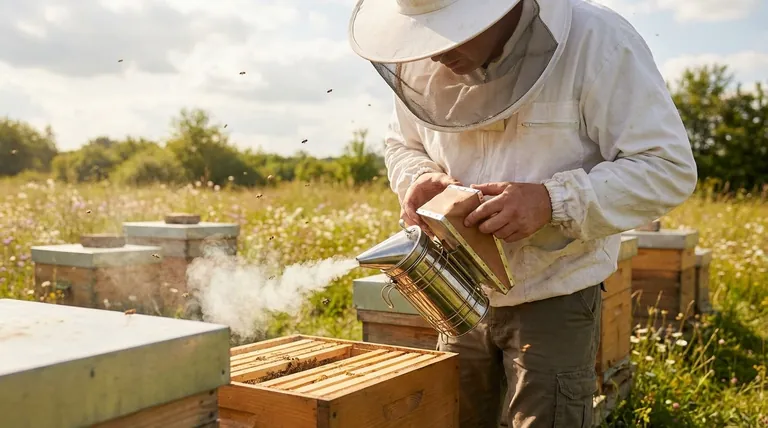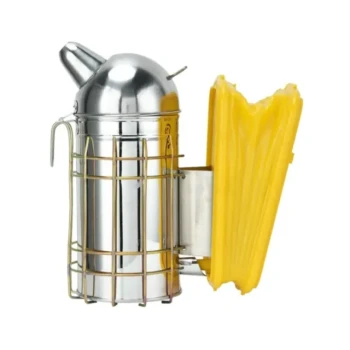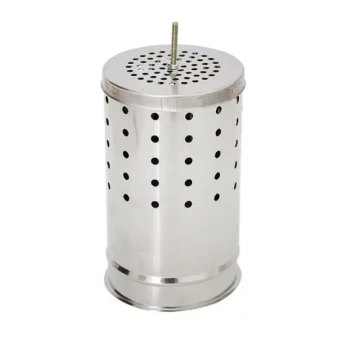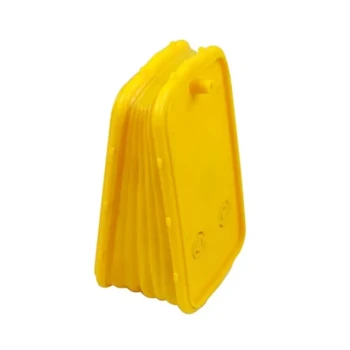To significantly reduce your chances of being stung, you must combine four key practices. Start with bees that have gentle genetics, always wear a veil, use a smoker correctly, and handle your bees with slow, deliberate movements. These actions work together to keep both you and your bees calm.
Preventing stings is less about wearing impenetrable armor and more about proactively managing your colony's stress. Your safety is a direct result of understanding bee behavior and approaching the hive with respect and a clear plan.

The Foundation: Managing Hive Temperament
The most effective way to prevent stings is to manage the colony's defensive instincts before you even open the hive. This is a proactive, not reactive, strategy.
Start with Gentle Genetics
A colony's temperament is largely determined by its queen. Purchasing a commercially reared queen known for gentle traits is the single best investment you can make for a calmer beekeeping experience.
An aggressive colony can be transformed over a few months simply by replacing the old queen with a gentler one. As her offspring replace the existing bees, the entire hive's disposition will improve.
Understand Hive Stressors
Bees don't sting out of malice; they sting in defense. Recognizing what causes them stress is key. Common stressors include poor weather (windy, cloudy, or rainy days), a lack of nectar (a "dearth"), a missing queen, or being disturbed by pests like skunks or wasps.
Your Role: Calm and Deliberate Handling
Your behavior during a hive inspection has a direct impact on the bees' response. They react to perceived threats, so your goal is to be as non-threatening as possible.
The Purpose of the Smoker
A smoker is not used to sedate bees. Cool, white smoke masks the alarm pheromone (isopentyl acetate) that guard bees release when they feel threatened.
Without this chemical signal spreading, a full-blown defensive response is far less likely to occur. The smoke also encourages bees to move down into the hive and consume honey, making them more preoccupied and less likely to fly up at you.
Move Slowly and Methodically
Sudden, jerky movements can be interpreted as a threat. Approach the hive calmly and perform all your actions—lifting lids, pulling frames, and using your hive tool—with smooth, predictable motions. Think of it as performing slow-motion tai chi.
Work During Optimal Conditions
Inspect your hives on warm, sunny, and calm days, typically between 10 a.m. and 4 p.m. During this time, a large portion of the colony's foragers are out of the hive, meaning fewer bees are home to defend it.
Essential Protective Gear: Your Last Line of Defense
While understanding behavior is primary, protective gear is non-negotiable, especially for beginners. It provides the confidence needed to work calmly, which in turn keeps the bees calm.
The Indispensable Veil
Your face and neck are the most critical areas to protect. A veil is the absolute minimum piece of protective equipment you should ever use. It prevents stings to sensitive areas and stops bees from getting tangled in your hair.
Sealing the Gaps
Bees have a tendency to crawl upwards into dark, confined spaces. Secure your pant legs by tucking them into your boots or socks or by using rubber bands.
Similarly, ensure your sleeves are secured at the wrist. Velcro straps or wristlets on a bee jacket are excellent for this, preventing bees from crawling up your arms. A full bee suit offers the most complete protection by design.
Understanding the Pitfalls
Even with the right knowledge, common mistakes can lead to stings. Being aware of them is critical for consistent safety.
Over-reliance on Gear
Feeling invincible inside a bee suit can lead to clumsy, rough handling. This agitates the colony, making them more defensive in the long run. Your gear is for safety, not an excuse to ignore the principle of gentle handling.
Improper Smoker Use
Using a smoker that produces hot smoke or sparks can harm and anger the bees. Likewise, using too little smoke will be ineffective. The goal is to produce cool, white puffs of smoke directed where you need it, not to fill the hive with a hot cloud.
Ignoring Colony Signals
The bees will tell you when they have had enough. If the pitch of the buzzing in the hive rises sharply or bees begin bumping your veil aggressively, it is a clear signal to finish your work quickly and close up the hive. Pushing through an inspection with a highly agitated colony is asking to be stung.
Making the Right Choice for Your Goal
Your approach to sting prevention should align with your experience level and the specific temperament of your bees.
- If your primary focus is maximum safety as a beginner: Invest in a full, ventilated bee suit and start your apiary with a nucleus colony or package of bees headed by a queen specifically bred for gentleness.
- If your primary focus is building handling skill: Use a smoker effectively and concentrate on reading the bees' behavior, but never work without at least a veil for protection.
- If your primary focus is managing a known defensive colony: Use full protective gear for every inspection and make a plan to requeen the hive with gentle genetics as the only viable long-term solution.
Ultimately, your safety is a partnership built on respect and a clear understanding of your bees' world.
Summary Table:
| Key Strategy | Core Action | Why It Works |
|---|---|---|
| Hive Temperament | Source gentle queens | Calmer bees are less defensive by nature. |
| Your Behavior | Use a smoker; move slowly | Masks alarm pheromones; avoids triggering a threat response. |
| Protective Gear | Always wear a veil; seal gaps | Essential protection for sensitive areas; prevents stings. |
| Avoiding Pitfalls | Read colony signals; don't rush | Knowing when to stop prevents agitating the hive. |
Ready to equip your apiary for safer, more productive beekeeping? HONESTBEE supplies commercial apiaries and beekeeping equipment distributors with high-quality, durable protective gear and essential tools like smokers. Our wholesale-focused operations ensure you get the reliable equipment you need to keep your teams safe and your colonies calm. Contact our team today to discuss your needs and get a quote!
Visual Guide

Related Products
- European Stainless Steel Bee Smoker for Honey Bee Hive
- Premium Traditional Copper Bee Smoker with Bellows
- Professional Bee Smoker with Elongated Spout and Durable Bellows for Beekeeping
- Heavy-Duty Bee Smoker with Durable Plastic Bellows for Beekeeping
- Electric Bee Smoker European Style Bee Hive Smoker for Beekeeping
People Also Ask
- What are the features of a recommended bee smoker? A Guide to Safety, Durability & Performance
- What are the benefits of smoking bees? Achieve Safer, Calmer Hive Inspections
- What are the benefits of cleaning a bee smoker? Ensure Hive Safety and Bee Health
- What are the steps to operate a bee smoker? Master the Art of Gentle Beehive Management
- What are the advantages of a high-quality bee smoker? Achieve Calm, Confident Hive Management



















